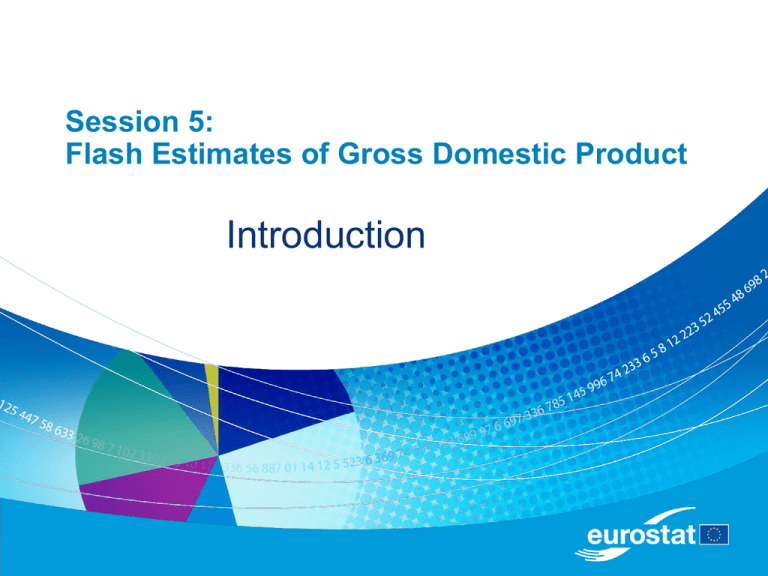Introduction Session 5: Flash Estimates of Gross Domestic Product
advertisement

Session 5: Flash Estimates of Gross Domestic Product Introduction Need of timely data: due to crisis and in general The economic and financial crisis underlined the importance of early statistical information on economic developments Flash estimates of GDP play prominent role as an aggregate measure of economic activity … …but early information is needed even without crisis The crisis has influenced the trade-off timeliness/accuracy in favour of timeliness A rough indication of economic stance by flash data is preferred to accurate but late information Facts about the EU Eurostat publishes flash estimate of GDP for the EU and EA 45 days after the end of the reference quarter well in advance of the 1st estimate available 60 days after the end of the reference quarter Both level and growth rate seasonally adjusted are estimated The flash estimate is based on flash estimates from the EU Member States. Occasionally other indicators are used. The EFC Status report on information requirements in EMU suggests repeatedly a target of 30 days after the end of the reference quarter Does the flash estimate solve the timeliness problem? Even at 30 days after the end of the reference quarter it only provides information what happened in the past rather than where the economy is at the moment Alternative solutions: nowcasts, coincident and leading indicators, business and consumer surveys, financial data, forecasting How far should statisticians go? Moreover: The imbalances in the economy which with some delay may lead to a cyclical downturn develop normally long before. Therefore attention should be paid also to data which illustrate these imbalances. The policy makers then are less surprised by the cyclical development. Does the flash estimate solve the timeliness problem? (continued) Flash estimates of GDP are used for decision-making in the areas of economic and monetary policies Time horizon within which monetary policy affects fully the economy is in the order of 1 – 2 years Does it then matter whether the information is available 2 weeks earlier or later? Yes it matters. The expectations channel of monetary policy works very fast. The CBs also normally wait until the information on changes in the economy is confirmed by more data, before they make the monetary policy decision. Flash estimate of GDP serves this purpose by « confirming » the information available from partial earlier data (industrial output, retail sales, exports/imports…) Further arguments in favour of flash estimates of GDP Flash estimates by statistical administrations have the status of official statistics. Quality profiles are available. Reduction of uncertainty in the economy. Which method and data to use for flash estimates of GDP? Many countries compile and publish flash estimates of GDP. But the methods and data used differ. One fits all solution or country specific approach? Small open economy versus big closed economy Structure of economy: Is IPI suitable when services represent prevailing part of the economy? Specificities of flash estimates in case of country groupings (EU, Euro area) Which method and data to use for flash estimates of GDP? (continued) Is the efficiency of the method and data used dependent on macroeconomic environment (stable growth, cyclical development)? Are soft data (confidence surveys) a better predictor of the turning points compared with hard data which don’t contain forwardlooking information? Are hard data really hard in case they are later revised? … but using hard data means similarity (consistence) with methods used for ordinary estimates of GDP Advantages and problems of soft data Guidelines on flash estimates Would it be good idea to have internationally adopted guidelines on compilation of flash estimates of GDP? Such guidelines would clearly define what is a flash estimate. Spreading of good methods and best practices would be supported. Comparability of statistics between countries would increase Quality of statistics in general would improve The policy makers on global level would have better chances to react to economic developments

